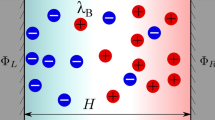Abstract
Supercapacitors are a key technology for the energy storage requirements of future energy systems. A primary problem of supercapacitors is their limited energy density, but new electrode materials and electrode designs might help to overcome this limitation. Numerical modelling can be a valuable tool in this challenge, although realistic ab initio calculations are usually very cumbersome. In this work, we show that electric double-layer capacitors can be modelled to good accuracy by a coarse-grained sampling of the electrolyte’s configuration space rather than using full molecular dynamics simulations. This saves considerable computation time, and it allows for processing more materials and more complicated systems with modest computational effort.



Similar content being viewed by others
References
Béguin F, Frackowiak E (eds) (2013) Supercapacitors: materials, systems and applications, 1st edn. Wiley-VCH, Weinheim
Kohn W, Sham LJ (1965) Phys Rev 140(4A):A1133. doi:10.1103/PhysRev.140.A1133
Makov G, Payne MC (1995) Phys Rev B 51:4014. doi:10.1103/PhysRevB.51.4014
Ando Y, Gohda Y, Tsuneyuki S (2013) Chem Phys Lett 556:9. doi:10.1016/j.cplett.2012.11.062
Otani M, Sugino O (2006) Phys Rev B 73(11):115407
Lany S, Zunger A (2009) Model Simul Mater Sci Eng 17(8):084002
Giannozzi P, Baroni S, Bonini N, Calandra M, Car R, Cavazzoni C, Ceresoli D, Chiarotti GL, Cococcioni M, Dabo I, Corso AD, Gironcoli Sd, Fabris S, Fratesi G, Gebauer R, Gerstmann U, Gougoussis C, Kokalj A, Lazzeri M, Martin-Samos L, Marzari N, Mauri F, Mazzarello R, Paolini S, Pasquarello A, Paulatto L, Sbraccia C, Scandolo S, Sclauzero G, Seitsonen AP, Smogunov A, Umari P, Wentzcovitch RM (2009) J Phys Condensed Matter 21(39):395502. doi:10.1088/0953-8984/21/39/395502
Bard A, Faulkner L, Leddy J, Zoski C (1980) Electrochemical methods: fundamentals and applications, vol 2. Wiley, New York
Bockris J, Reddy A (2001) Modern electrochemistry 2B: electrodics in chemistry, engineering, biology and environmental science, vol 2. Springer Science and Business Media, New York
Masliyah J, Bhattacharjee S (2006) Electrokinetic and colloid transport phenomena. Wiley, New York
Enkovaara J, Rostgaard C, Mortensen JJ, Chen J, Dulak M, Ferrighi L, Gavnholt J, Glinsvad C, Haikola V, Hansen HA, Kristoffersen HH, Kuisma M, Larsen AH, Lehtovaara L, Ljungberg M, Lopez-Acevedo O, Moses PG, Ojanen J, Olsen T, Petzold V, Romero NA, Stausholm-Mller J, Strange M, Tritsaris GA, Vanin M, Walter M, Hammer B, Hkkinen H, Madsen GKH, Nieminen RM, Nrskov JK, Puska M, Rantala TT, Schitz J, Thygesen KS, Jacobsen KW (2010) J. Phys.: Condensed Matter 22(25). doi:10.1088/0953-8984/22/25/253202
Perdew JP, Burke K, Ernzerhof M (1996) Phys Rev Lett 77(18):3865. doi:10.1103/PhysRevLett.77.3865
Formaro L, Trasatti S (1968) Anal Chem 40(7):1060. doi:10.1021/ac60263a003
Lockett V, Horne M, Sedev R, Rodopoulos T, Ralston J (2010) Phys Chem Chem Phys 12:12499. doi:10.1039/C0CP00170H
Acknowledgments
The authors would like to thank the National Institute for Theoretical Physics (NITheP), the Mandelstam Institute for Theoretical Physics (MITP), the Materials Physics Research Institute (MPRI), the Materials for Energy Research Group (MERG) and the DST-NRF Centre of Excellence in Strong Materials (CoE-SM) for support.
Author information
Authors and Affiliations
Corresponding author
Rights and permissions
About this article
Cite this article
Warmbier, R., Malaza, N. & Quandt, A. Double-layer capacitance for a charged surface. Ionics 23, 331–335 (2017). https://doi.org/10.1007/s11581-016-1813-z
Received:
Revised:
Accepted:
Published:
Issue Date:
DOI: https://doi.org/10.1007/s11581-016-1813-z




